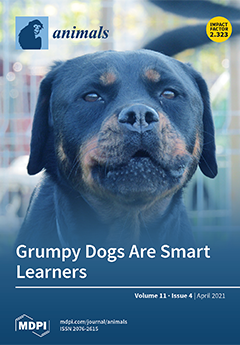This study isolates and identifies
Pichia anomala (
P. anomala) AR
2016, and studies its effect on the growth and health of weaned pigs. A
P. anomala strain from solid wine koji is isolated and identified using 26S rDNA analysis, and its culture conditions are optimized. Heat tolerance, bile salt tolerance, artificial gastric, and intestinal juice tolerance are evaluated. In our methodology, thirty 28 d Large White × Landrace × Rongchang weaned pigs were randomly divided into three groups with 10 barrows in each, and fed a maize-soybean meal diet and orally administered 0.85% saline (CK), 1 mL 1 × 10
9 cfu/mL
Candida utilis (
C. utilis), and 1 mL 1 × 10
9 cfu/mL
P. anomala once daily for 28 days. A
P. anomala strain was identified and named
P. anomala AR
2016.
P. anomala AR
2016 grew best in yeast extract peptone dextrose medium with pH 5.0 at 28 °C, 180 r/min and could tolerate 45 °C for 0.5 h, 0.2% pig bile salts, simulated gastric fluid, and 1.0% simulated intestinal fluid. Our results show that compared with the CK group, orally administered
P. anomala AR
2016 increases average daily gain, the ileal villus height, the ileal mucosal concentrations of occludin and zonula occluens-1, the serum glucose and total protein concentration, total superoxide dismutase, glutathione peroxidase, and total antioxidative capacity activity, the trypsin and lipase activity in jejunal and ileal contents, the jejunal and ileal mucosa mRNA levels of ALP, TNF-α, and TLR-2, and the relative abundance of Bacteroidetes, Actinobacteria, Succinivibrionaceae, Lachnospiraceae, and Prevotellaceae (
p < 0.05). Compared with the CK group, oral administration of
P. anomala AR
2016 decreased the incidence of diarrhea, aspartate aminotransferase activity, alanine amino-transferase-activity, malondialdehyde, D-lactic acid and endotoxin content in serum, the mRNA level of aminopeptidase N of ileum mucosa, and the relative abundance of Proteobacteria, Clostridiaceae, Campylobacteraceae, Vibrionaceae,
Bacillus, and Pseudon (
p < 0.05). Collectively, the study indicates that
P. anomala AR
2016 can tolerate high acidity and high bile salts, and has high survivability in the artificial gastric intestinal juice environment. Oral administration of
P. anomala AR
2016 improves the growth performance, reduces the incidence of diarrhea, enhances intestinal barrier function, and improves microflora in weaned pigs.
Full article






